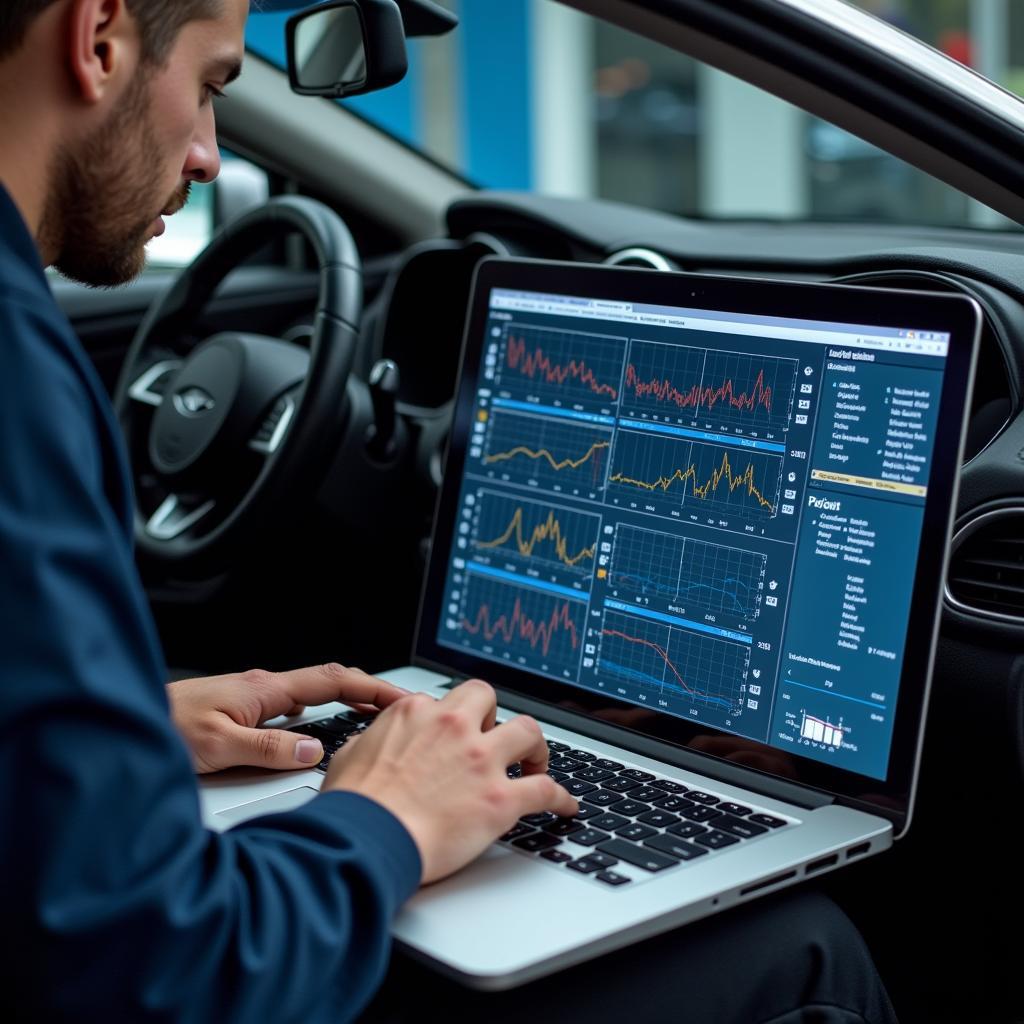Diagnostic car computer mechanics is revolutionizing the way we troubleshoot and repair vehicles. Gone are the days of relying solely on mechanical expertise and intuition. Today’s sophisticated automobiles demand a deep understanding of complex electronic systems and the ability to interpret the data they generate. This article delves into the intricacies of diagnostic car computer mechanics, providing a comprehensive overview of its importance, the tools involved, and the skills needed to excel in this field. Check out our guide on how difficult it is to use a car diagnostic tool.
The Importance of Diagnostic Car Computer Mechanics
Modern vehicles are essentially computers on wheels, equipped with numerous Electronic Control Units (ECUs) that manage everything from engine performance and fuel efficiency to safety features and entertainment systems. When a problem arises, these ECUs store diagnostic trouble codes (DTCs) that pinpoint the source of the malfunction. Diagnostic car computer mechanics involve retrieving and interpreting these codes, allowing technicians to accurately diagnose and repair issues quickly and efficiently. This minimizes guesswork, reduces repair time, and ultimately saves car owners time and money.
Diagnostic car computer mechanics is also crucial for preventative maintenance. By regularly analyzing vehicle data, technicians can identify potential problems before they escalate into major repairs. This proactive approach extends the lifespan of vehicle components, enhances reliability, and contributes to overall road safety.
Essential Tools for Diagnostic Car Computer Mechanics
A variety of specialized tools are essential for effective diagnostic car computer mechanics. These include:
- Code Readers/Scanners: These devices retrieve DTCs from the vehicle’s OBD-II port. Basic code readers display the codes, while more advanced scanners provide detailed information about the fault.
- Diagnostic Software: Software applications running on laptops or tablets offer more sophisticated diagnostic capabilities, including live data streaming, actuator tests, and access to manufacturer-specific information. You can even find free car diagnostic software online.
- Multimeters: These versatile tools measure voltage, current, and resistance, helping pinpoint electrical faults in various vehicle systems.
- Oscilloscope: An oscilloscope allows technicians to visualize electrical signals, aiding in the diagnosis of complex sensor and actuator issues.
Developing Skills in Diagnostic Car Computer Mechanics
Becoming proficient in diagnostic car computer mechanics requires a combination of technical knowledge and practical skills. Here are some key areas to focus on:
- Understanding Automotive Electronics: A solid foundation in automotive electrical systems is crucial. This includes knowledge of sensors, actuators, ECUs, and communication networks like CAN bus.
- Interpreting Diagnostic Trouble Codes: Knowing how to decipher DTCs and understand their meaning is fundamental to accurate diagnosis.
- Using Diagnostic Software: Proficiency in using diagnostic software is essential for accessing and interpreting vehicle data. Check out the Delphi DS150E car and truck diagnostic tool.
- Analytical and Problem-Solving Skills: Diagnostic car computer mechanics often involve tracing complex problems through logical deduction and critical thinking.
How to Run Diagnostics on Your Car
Many modern vehicles allow you to run basic diagnostics yourself. This involves accessing the OBD-II port, usually located under the dashboard on the driver’s side. You can then use a code reader or a smartphone app to retrieve DTCs. However, for more in-depth diagnostics and repairs, it’s essential to consult a qualified technician with the appropriate tools and expertise. Learn more about how to run diagnostics on your car.
 Mechanic Using Diagnostic Software on Laptop
Mechanic Using Diagnostic Software on Laptop
Conclusion
Diagnostic car computer mechanics is no longer a niche skill but a fundamental requirement for modern automotive repair. By embracing these technologies and developing the necessary skills, technicians can ensure accurate diagnoses, efficient repairs, and enhanced customer satisfaction. Understanding diagnostic car computer mechanics is crucial for keeping your vehicle running smoothly and safely in today’s technologically advanced automotive landscape.
FAQ
- What is the OBD-II port? The OBD-II port is a standardized connector that provides access to a vehicle’s diagnostic data.
- What are DTCs? DTCs are codes stored in a vehicle’s computer that indicate specific malfunctions.
- Can I diagnose my car myself? You can run basic diagnostics using a code reader or smartphone app, but complex issues require professional expertise.
- What is a CAN bus? A Controller Area Network (CAN bus) is a communication network that connects various ECUs in a vehicle.
- Why is diagnostic car computer mechanics important? It enables accurate and efficient troubleshooting, minimizing guesswork and reducing repair time.
- What tools are used in diagnostic car computer mechanics? Tools include code readers, diagnostic software, multimeters, and oscilloscopes.
- How can I learn more about diagnostic car computer mechanics? Several online resources, training programs, and automotive schools offer courses on this subject.
You might also be interested in learning about the Lenovo car diagnostic machine price.
Need help with your car diagnostics? Contact us via WhatsApp: +1(641)206-8880 or Email: [email protected]. Our team is available 24/7 to assist you.


